Breaking Boundaries With Savory Ingredients
INGREDIENTS
There’s a buzz about a certain taste sensation that’s adding excitement to food products and leading to creative ingredient developments. It’s savory taste, and it can be detected not only in common food ingredients like salt and yeast extracts but also in others that many product developers may not commonly use, such as fish sauce and kombu. Another level of savory includes umami and kokumi, two words coined by Japanese researchers to describe savory richness and rounded mouthfeel, respectively. Umami is the more recognizable of the two terms among product developers and culinary professionals, although kokumi is emerging; snacks, sauces, and noodle dishes are applications that are perfect to deliver on kokumi taste, according to market research firm Mintel. While umami does not have an exact English translation, it is often interpreted as “deliciousness.” The amino acid glutamate is most responsible for the umami taste sensation (along with ribonucleotides), which is why foods high in glutamate like mushrooms, tomato paste, Parmesan cheese, miso, and anchovies are such effective savory flavor enhancers and add complexity and flavor roundness to foods. Umami flavor compounds also function to increase perceived saltiness and are therefore used to reduce sodium in many food products.
Plenty of old standby ingredients that boost salty and savory tastes are still in use, too, with some having different twists put on them. Asian sauces like soy sauce and fish sauce are moving beyond Asian cuisine to other foods, where they add rich, salty, fermented flavor notes, for instance. Sea salt is combined with other ingredients (sweet, sour, hot, spicy, herby, and smoke) for additional layers of flavor. Plus, ingredient developers and food technologists are tinkering with these savory ingredients, formulating them into all sorts of food applications, including some that are quite unexpected.
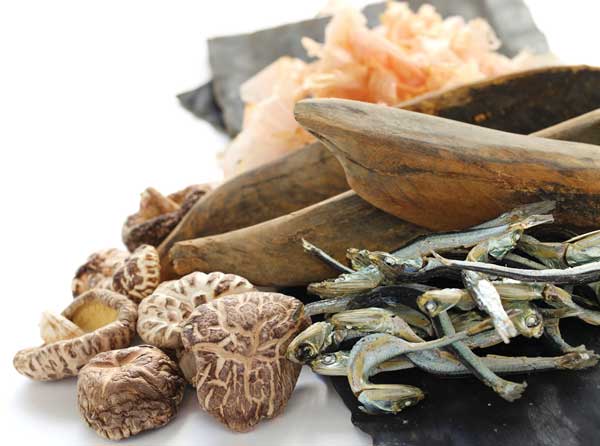 Give Foods a Boost of Umami, Kokumi
Give Foods a Boost of Umami, Kokumi
Want to kick up the umami and kokumi tastes in foods using one simple, naturally derived ingredient? Ajinomoto North America, Itasca, Ill. (ajiusafood.com), has just the ingredient to do the job in its Savorboost line. These yeast and yeast-based ingredients can enhance upfront umami or kokumi taste characteristics without adding a distinctive yeast flavor to the finished food products.
Three distinct ingredients make up the Savorboost line. Savorboost U enhances upfront umami flavor often described as savoriness. It is listed as “yeast, yeast extract” on labels. The second ingredient is Savorboost K, a yeast extract that delivers background richness and roundness—the kokumi taste sensations—to savory products. This ingredient is also labeled as “yeast extract, yeast.” The final Savorboost ingredient is Savorboost F, which is used to provide both umami and kokumi tastes that add levels of flavor complexity to foods. Very small amounts of the ingredients are needed in order to provide the desired flavor effects. Product developers can even work these ingredients into applications that feature reduced monosodium glutamate (MSG) or reduced sodium.
The company’s food technologists have formulated a number of product concepts using the Savorboost ingredients to add the “deliciousness” taste sensation. Savorboost U in chicken broth is said to enhance the meaty chicken flavor and deliver richness and longer-lasting flavor. Snack seasoning made with Savorboost F has an initial burst of umami flavor and a general complex flavor. Savorboost K adds a richness and longer-lasting flavor while reducing sodium in 50% reduced-sodium tamari. At the IFT15 food expo, the company gave attendees the chance to try the savory-enhancing properties of the Savorboost ingredients in Vietnamese pho, Alfredo sauce, taco meat, and dipping sauce for jerk chicken.
--- PAGE BREAK ---
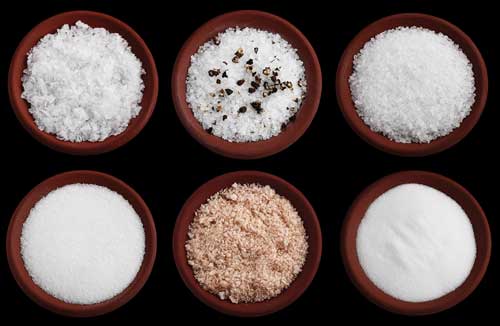 Sea-ing New Uses for Sea Salt
Sea-ing New Uses for Sea Salt
Sea salt—produced through the evaporation of sea water—has found favor among some product developers and culinary professionals for its functional benefits, namely texture and flavor. Consumers, too, are drawn to sea salt because they believe it is “less processed” than table salt, which is mined from underground salt deposits, processed to remove minerals and impurities, and usually combined with an additive to prevent clumping.
Sea salt is commonly used as a finishing salt sprinkled on salads, cooked meat and fish, vegetables, snack foods like chips, and chocolate pieces, where it adds an initial bright, salty taste, crunch, and—depending on the water source—flavor and color (the flavor and color come from trace minerals and elements in sea water). SaltWorks, Woodinville, Wash. (saltworks.us), bills itself as “America’s Sea Salt Company,” and it lives up to this description by offering an extensive line of gourmet sea salts in bulk and for retail sale. Some of the sea salts come from Hawaii, Italy, and several regions in France. Because the mineral content of the water in each location is different, the salts produced from the local waters have different colors and flavors.
The company takes basic sea salt and pairs it with various naturally derived, flavorful ingredients like espresso beans, green tea, curry powder, maple syrup, Trinidad Scorpion peppers, and red wine using a proprietary process to create its line of Fusion salts. The 25 varieties include versions that are sweet, tart, savory, pungent, or spicy hot that add flavor dimensions to many different foods. Some of the serving suggestions courtesy of SaltWorks include topping desserts like cheesecake with Espresso Brava, vanilla ice cream with Thai Ginger, and caramels with Smoked Serrano. The Lime Fresco and Chili Verde versions add a flavor burst to flaky white fish. Sprinkle Thai Ginger, Szechuan Pepper, or Spicy Curry sea salts on Asian noodle dishes, or try Spanish Rosemary or Roasted Garlic in tomato sauce to top pasta. More applications that the company promotes are meat, salads, and vegetables.
SaltWorks also cold-smokes sea salt with untreated wood (hickory, alderwood, pecan, applewood, oak wine barrels, and mesquite) to produce smoked sea salts that give foods smoky flavors without having to fire up the grill. It goes without saying that the smoked sea salts make perfect dry rubs for meat, but the company also suggests other applications where the smoked sea salts add unexpected layers of flavor. Mash it into baked sweet potatoes or potato salad, or add it to macaroni and cheese sauce or creamy pasta sauces. Sprinkle just a bit over popcorn, chocolate/fudge, ice cream, roasted fruit, sliced tomatoes, melon, pumpkin seeds, caramel apples, corn on the cob, eggs, and alcoholic beverages (think a Bloody Mary or a Margarita).
According to the American Heart Association (AHA), 61% of respondents to a survey it conducted incorrectly agreed that sea salt is a low-sodium alternative to table salt. Table salt and most sea salts, the AHA explains, have comparable amounts of sodium by weight, but because some sea salt varieties have larger crystal sizes than table salt, they may have less sodium by volume. A teaspoon of table salt has about 2,300 mg of sodium, but a teaspoon of sea salt may have less sodium because fewer crystals fit into the spoon, according to the organization. Some ingredient manufacturers promote sea salt as a salt reduction tool by combining it with other ingredients that have salty and umami taste characteristics, thus allowing food manufacturers to use less overall sodium in their products while maintaining the savory taste. Salt of the Earth, Atlit, Israel (saltoftheearthltd.com), launched Umamix, a proprietary mix of sea salt and vegetable extracts, at the 2015 Food Ingredients Europe show in December. Salt from the Red Sea is combined with extracts from tomato, shiitake mushrooms, and kombu seaweed—all foods that have high amounts of compounds that elicit umami taste—to create a liquid ingredient that the company says can help reduce sodium by up to 45% and replace MSG in many processed meat applications. Food technologists at the company demonstrated that Umamix can decrease sodium by 45% in hamburgers and meatballs and by 33% in sausages without affecting the taste. The ingredient is heat stable, pH stable, and kosher and halal. And since it is made from sea salt and naturally derived vegetable ingredients, it is an option for food manufacturers formulating products to meet clean label demands of consumers, according to the company.
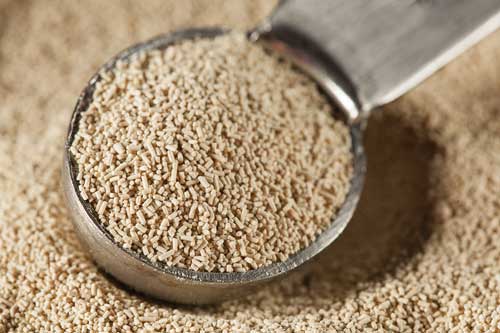 Yeast Ingredients Lend Savory Flavor
Yeast Ingredients Lend Savory Flavor
Walk through any food ingredient trade show and it seems that more ingredient options exist for developers of organic products than ever before. For organic products with a savory flavor, product developers can turn to a line of organic yeast-based ingredients from Lallemand, Montreal, Quebec, Canada (lallemand.com).
The company debuted the organic yeasts last summer at the IFT15 expo. To produce them, the company grows yeast on organically produced and certified agricultural substrates. The result is inactive yeast, which is whole cell yeast derived from primary-grown or brewer’s yeast, and yeast extracts, which are the soluble yeast fractions. Product developers can choose from four organic yeast ingredients. Bio-Engevita S Powder is an organic inactive yeast powder and Bio-Engevita S Flakes are organic inactive yeast flakes. Both of these have savory flavor characteristics as well as water-binding and emulsifying properties. The other two ingredients—Bio-Lyfe 537 A and Bio-Lyfe 537 C—can enhance savory and meaty flavors. Both are organic yeast extracts with natural 5’nucleotides, with the Bio-Lyfe 537 C ingredient containing salt. Use these in any traditionally savory application.
--- PAGE BREAK ---
Asian Sauces Add Savory Twist
Singular ingredients like sea salt and yeast extracts are popular options for adding salty and savory tastes to foods, but sauces, particularly those used in Asian cuisine, are key flavor enhancers, too. Intensely flavored sauces such as fish, soy, and oyster are high in savory/umami compounds and are used as finishing sauces, condiments, and flavor enhancers. Naturally brewed soy sauce, for example, is high in glutamic acid, a nonessential amino acid that contributes to umami taste and works in synergy with salt to enhance the umami taste even more. In a Journal of Food Science review article, Lioe et al. (2010) write that free L-glutamic acid and other free amino acids may interact with other tastants to elicit umami taste.
Long cooking times produce rich, meaty flavors such as in a stew or soup prepared by a home cook. Food manufacturers producing processed food products often follow a more rapid production schedule. Kikkoman, which has specialized in soy sauce production for several centuries, suggests that adding just a little soy sauce to formulas can lend some of these rich savory flavors to processed food products. Through its Kikkoman Sales USA division, San Francisco, Calif. (kikkomanusa.com/foodmanufacturers; kikkomanusa.com/foodservice), the company offers a number of different soy sauce products as well as other full-flavored savory sauces that boost umami taste in both Asian and non-Asian food products.
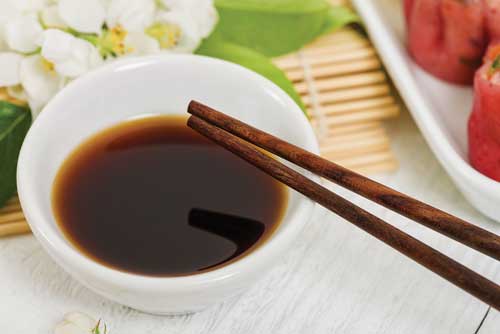 Soy sauce has been an important ingredient in Asian cooking for centuries, and Joe Leslie, industrial sales manager at Kikkoman Sales USA, is excited to say that his company’s soy sauces are now providing richness, flavor depth, and aroma to many non-Asian applications like cheese items, snack foods, dried meats, frozen meals, salad dressings, sauces, gravies, and baked goods. Manufacturers also have to contend with developing craveable foods that meet consumers’ clean label expectations. “We find soy sauce being used in small quantities to replace flavor enhancers that are no longer desired on the label,” says Leslie. “This is beneficial to manufacturers as soy sauce is among the lowest-cost and cleanest-label options available.”
Soy sauce has been an important ingredient in Asian cooking for centuries, and Joe Leslie, industrial sales manager at Kikkoman Sales USA, is excited to say that his company’s soy sauces are now providing richness, flavor depth, and aroma to many non-Asian applications like cheese items, snack foods, dried meats, frozen meals, salad dressings, sauces, gravies, and baked goods. Manufacturers also have to contend with developing craveable foods that meet consumers’ clean label expectations. “We find soy sauce being used in small quantities to replace flavor enhancers that are no longer desired on the label,” says Leslie. “This is beneficial to manufacturers as soy sauce is among the lowest-cost and cleanest-label options available.”
There are gluten-free and lower-sodium versions of soy sauce and tamari soy sauce, including one of the company’s newest ingredients, Kikkoman Less-Sodium, Gluten-Free Non-GMO Tamari Soy Sauce with 40% less sodium than regular gluten-free tamari soy sauce. Using this ingredient allows manufacturers to reduce sodium without sacrificing flavor intensity, says Leslie.
Other Kikkoman sauces like katsu sauce, a combination of apples, onions, tomato paste, and soy sauce, and teriyaki sauce, made from soy sauce, vinegar, sweetener, and seasonings, not only provide savory flavors to foods but also a bit of sweetness. For use in applications where a liquid sauce just won’t work, there are dehydrated and granulated soy sauce ingredients that easily incorporate into seasoning blends, snack food coatings, concentrated soup bases, and powdered mixes. Kikkoman’s dehydrated and granulated soy sauce ingredients are produced through a spray-drying method. The free-flowing powders have demonstrated flavor retention during heat processing and freezing and can be easily reconstituted in water.
“Kikkoman soy sauces are now used in so many items that nothing surprises us anymore,” says Leslie. “You can find our soy sauce in unexpected applications such as pet foods, cheese spreads, and low-sodium breads. Kikkoman’s non-GMO sriracha sauce is also found in food products across the spectrum,” he continues. “Our hoisin sauce, ponzu sauce, Thai chili sauce, and plum sauce provide a savory kick to many signature sauces found in prepared foods and restaurants.”
Research Yields Savory Ingredients
Savory taste is one area where Senomyx, San Diego, Calif. (senomyx.com), has conducted plenty of research. The first ingredients to be developed under the company’s Savory/Umami Taste Program received regulatory approval in the United States in 2005 and were commercialized by one of the company’s partners a couple of years later, says Sharon Wicker, senior vice president and chief commercial development officer at Senomyx. The company now has seven savory ingredients under the program, two of which are the most broadly commercialized.
--- PAGE BREAK ---
The ingredients—Savorymyx UM80 and Savorymyx UM33—are flavors that add subtle taste notes to food and beverage products. Savorymyx UM80 gives foods well-rounded, clean upfront umami/savory notes while Savorymyx UM33 provides meaty, peppery, and spicy taste notes when used at low levels. In addition to adding savory and umami complexity to foods, the ingredients also function to reduce sodium, MSG, and yeast extracts in certain applications, adds Wicker. It is not a significant reduction, but they still allow product developers to dial back the sodium a bit. (Wicker says it could be around a 20% reduction depending on the application.)
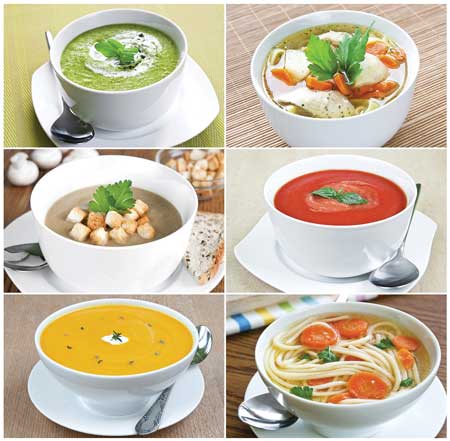 So in what food products can you find the Savorymyx ingredients? Commercialized products formulated with the ingredients include bouillon, soup, dry soup mixes, sauces, and seasoning blends. Wicker says that these are obvious examples, but that the ingredients do have potential in non-savory applications, which is something that some of the flavor chemists who work for Senomyx’s customers are investigating.
So in what food products can you find the Savorymyx ingredients? Commercialized products formulated with the ingredients include bouillon, soup, dry soup mixes, sauces, and seasoning blends. Wicker says that these are obvious examples, but that the ingredients do have potential in non-savory applications, which is something that some of the flavor chemists who work for Senomyx’s customers are investigating.
In addition to work on savory/umami taste, Senomyx conducts research on salty taste, says Wicker. Overall, this involves determining the mechanism for how salt taste perception works. One of the steps is to determine the specific protein or groups of proteins in taste buds that detect salt in food, according to the company’s Salt Taste Program. So far, Senomyx scientists have identified a small group of proteins they think may be involved in salt taste perception. When the research results definitively point to the proteins that enable salt taste perception, the scientists can then use them to develop new flavor ingredients such as taste modifiers that allow for significant reductions in sodium.
Dusting of Powder Gives Umami Boost
Umami is a much talked about taste sensation that gives foods rounded, mouth-watering, and savory effects. Ingredients rich in umami compounds like MSG and autolyzed yeast extract (AYE) give foods an umami boost, but to some consumers, these are not so-called label-friendly ingredients. For that reason, some ingredient manufacturers have used ingredients like mushrooms and umami-rich vegetables to produce different types of umami powders that manufacturers can use in clean label product development.
The first one, called Umami Natural, comes from Sensient Natural Ingredients, Turlock, Calif. (sensientnaturalingredients.com). This specially formulated blend of vegetable powders gives a deep, savory flavor to all sorts of savory food applications. Developers of reduced-sodium products take note: Umami Natural has 380.94 mg of sodium/100 g versus 4,460.00 mg of AYE/100 g and 12,300.00 mg of MSG/100 g.
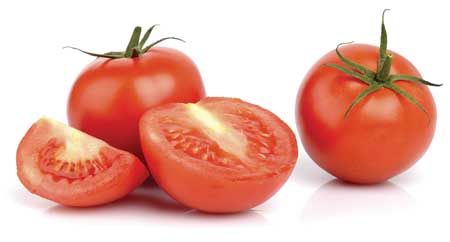 Woodland Foods, Waukegan, Ill. (woodlandfoods.com), blended dried porcini and shiitake mushrooms, aromatic vegetables, tomato powder, dried chilies, miso powder, and salt to create Umami Dust Seasoning. Mushrooms, tomatoes, and miso are naturally rich sources of umami taste compounds. The finely ground, tan-colored powder can be used as a topical application on meat and fish or incorporated into product like soups, stews, and ground meat.
Woodland Foods, Waukegan, Ill. (woodlandfoods.com), blended dried porcini and shiitake mushrooms, aromatic vegetables, tomato powder, dried chilies, miso powder, and salt to create Umami Dust Seasoning. Mushrooms, tomatoes, and miso are naturally rich sources of umami taste compounds. The finely ground, tan-colored powder can be used as a topical application on meat and fish or incorporated into product like soups, stews, and ground meat.
The final umami powder ingredient is Umami Sensations from RC Fine Foods, Hillsborough, N.J. (rcfinefoods.com). Umami Sensations is actually a line of 10 umami powders made from different umami-rich sources that bring out layers of flavor in a variety of products, from soups to desserts. The collection includes Fish Sauce Powder, Oyster Extract Powder, Kombu (Seaweed) Powder, Champignon Mushroom Extract Powder, Shitake Mushroom Extract Powder, Roasted Chinese Cabbage Powder, Mirepoix Powder, Soy Sauce (Wheat-free) Powder, Red Miso Powder, and Kokumi Powder. Because the powders help to increase the umami and savory taste sensations, they can replace some of the added sodium in products. In some cases, not much of the powder is needed; the company gives the example of using as little as 1/2 teaspoon of the powder in one gallon of soup. The powders are available in 4 oz spoonable jars and 2 oz shaker bottles. RC Fine Foods promotes the powders as easy-to-use ingredients for foodservice applications.
--- PAGE BREAK ---
Umami Chocolate for Unexpected Flavor
Mushroom extract powder, soy sauce powder, and red miso powder used to heighten umami taste sensations in savory applications like sauce and meat dishes is expected. But used as an ingredient in sweet applications like chocolate truffles? Not so much. Food technologists at Nikken Foods USA, St. Louis, Mo. (nikkenfoods.com), developed truffles formulated with small amounts of these ingredients, not to create a savory chocolate treat, but to temper the sweetness of the confection a bit while enhancing the overall flavor. Similar to how the addition of a small amount of coffee or espresso to chocolate cake brings out a stronger roasted chocolate flavor, these powdered ingredients also enrich the chocolate flavor in truffles. At various food industry shows in 2015, attendees sampled conventional truffles along with those made with umami-enhancing ingredients to taste how the ingredients helped create deeper, richer flavors.
The company says that the umami- and kokumi-enhancing properties of its soy sauce powders, seafood extract powders, vegetable and mushroom extract powders, and other specialty blends “create the ultimate YUM-ami” across all food applications.
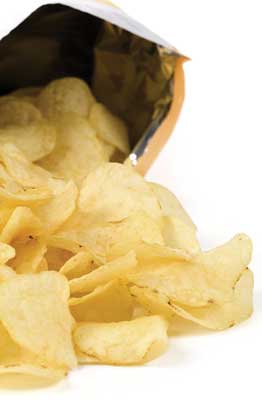 Its three Umami Medley blends in particular help create the mouthwatering experience and bring layers of flavor to foods. Each blend combines umami-boosting ingredients that act synergistically to boost the savoriness of foods. The collection includes Umami Medley 7501, a blend of kombu and shiitake extracts, and Umami Medley 7503, a combination of extracts from fermented rice, shiitake, and kombu. The third ingredient, Umami Medley 7502, blends Komi Powder, Nikken’s kokumi enhancer made from fermented soybean sauce, with soy sauce powder and shiitake extract. The umami and kokumi properties of the ingredients mean that product developers can formulate many products with less sodium without affecting the flavor complexity or mouthfeel, according to the company.
Its three Umami Medley blends in particular help create the mouthwatering experience and bring layers of flavor to foods. Each blend combines umami-boosting ingredients that act synergistically to boost the savoriness of foods. The collection includes Umami Medley 7501, a blend of kombu and shiitake extracts, and Umami Medley 7503, a combination of extracts from fermented rice, shiitake, and kombu. The third ingredient, Umami Medley 7502, blends Komi Powder, Nikken’s kokumi enhancer made from fermented soybean sauce, with soy sauce powder and shiitake extract. The umami and kokumi properties of the ingredients mean that product developers can formulate many products with less sodium without affecting the flavor complexity or mouthfeel, according to the company.
Recognition for Scelta Flavor Enhancer
Mushrooms are an umami powerhouse, and Scelta Mushrooms, Venlo, the Netherlands (sceltamushrooms.com), has harnessed the umami goodness in mushrooms to produce Scelta Taste Accelerator, a potassium-free flavor enhancer of umami taste and salty perception suited for use in reduced-sodium applications. It is a blend of mushroom extracts and umami-rich vegetable extracts that functions as a naturally derived alternative to MSG and AYE. The ingredient recently won two 2015 Food Ingredients Europe Innovation Awards: one for Most Innovative Food Ingredient and one in the category of Best Functional Innovation.
Product developers can choose from a liquid or powder form for use in all types of savory applications. A little goes a long way; in most formulations, either version of Scelta Taste Accelerator can be used in amounts from 0.15% to 0.30% to get the desired umami and salty taste effects, or they can be used to achieve sodium reductions of up to 50%. There is also a powdered version specifically designed for use in bread that allows for sodium reductions between 25% and 50%. Finally, there is a Scelta Taste Accelerator version for topical use on chips, nuts, and other savory products. The ingredient also has sodium-reduction benefits. In all of these cases, the company has demonstrated that sodium reduction is achieved without compromising taste or the functionality of salt.
Next month’s Ingredients section will feature ingredients that enhance texture and maintain stability in foods and beverages.
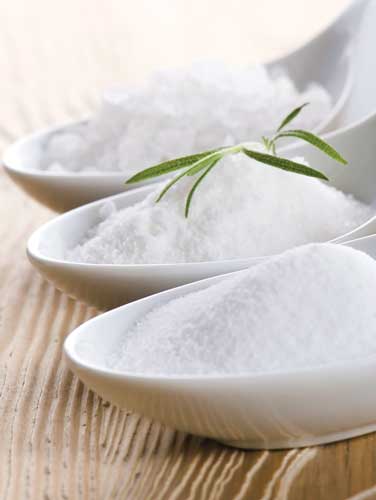 Leading Salt Manufacturer Adds to Lineup
Leading Salt Manufacturer Adds to Lineup
Morton Salt, Chicago (mortonsalt.com), has made a major investment in both ingredient innovation and salt production capabilities. The company, which has more than 50 salt grades and mixtures available to food manufacturers, added PureSun Culinary Crystals to its collection to meet the growing demand for sea salt. The salt is harvested from the Great Salt Lake in Utah and produced through solar evaporation, the oldest method of salt production, which involves putting sea water in shallow ponds where the sun evaporates most of the water. When the salt layer is thick enough, it is harvested using a mechanical harvesting machine. The ingredient joins other Morton Salt ingredients—from the standard table salt that we are all familiar with to specialty salts like Sea Salt Rubs blended with spices and herbs, Seasoned Salt, and Popcorn Salt. Other varieties include sea salts, salts in different grades and grinds, and low-sodium salt that incorporates potassium chloride in the blend.
PureSun Culinary Crystals is the first food-grade salt ingredient produced at the company’s Grantsville, Utah, facility. The company also introduced food-grade salt manufacturing capabilities to its salt production facility in Port Canaveral, Fla., by expanding it by more than 45,000 sq ft. Production of food-grade salt ingredients at that location is expected to begin in the first quarter of 2016.
--- PAGE BREAK ---
Ingredient Roundup
Ingredients derived from various sources offer product developers several options to enhance savory and salty flavors, round out flavors, and add umami taste characteristics to foods.
• Biorigin, Louisville, Ky. (bioringin.net), starts with select strains of Saccharomyces cerevisiae to produce Bionis yeast extract. The ingredient can improve overall savory and umami flavors while adding roasted taste notes. Bioenhance flavors are made from bacterial fermentation using a strain of dairy cultures that is not genetically modified. Using Bioenhance is said to give foods a more rounded flavor that is heavy on umami taste and salt perception without sodium addition. To give foods what the company describes as a mouth-watering savory flavor, there is a naturally derived flavor called BioSavour, which also boosts umami taste. Biotaste yeast extracts give foods various roasted notes and meaty flavor profiles like chicken and beef.
• Reducing sodium in products but still maintaining the salty taste impact is possible with yeast-derived ingredients from Bio Springer, Milwaukee, Wis. (biospringer-na.com). Springer 2000 yeast extracts with naturally occurring nucleotides boost salty notes and add umami flavor while Springer 4000 yeast extracts give foods richness and kokumi taste. Springer Standard yeast extracts with savory and vegetable flavor profiles can provide subtle flavors to foods. Springarom is a processed flavor ingredient derived from yeast extracts that can be used to add back or boost specific flavor notes. Finally, Springaline and Springalys are dried yeast ingredients used as flavor carriers and flavor base notes, and they also lend roasted or nutty notes to food products.
• To give vegan and vegetarian food products a meaty, savory flavor, Eatem Foods, Vineland, N.J. (eatemfoods.com), manufactures Vegan Broth Concentrate 90-451 (Chicken Type). Yeast extract is the main savory-boosting ingredient used in the concentrate along with naturally derived flavorings and salt. These help give it a roasted chicken aroma and meaty flavor of chicken stock without the use of meat ingredients. Other ingredients like onion powder, garlic powder, and evaporated cane juice contribute to the overall flavor of the broth concentrate. Vegan Broth Concentrate is a brown-colored, spreadable paste that can be used to formulate broths and soups, sauces and gravies, vegan patties and nuggets, meat analogs, side dishes like beans and rice, and marinades.
• Savoury Systems International, Branchburg, N.J. (savourysystems.com), specializes in yeast extracts and savory flavors that help food product developers to enhance salty, savory, brothy, meaty, and umami tastes in food applications. The company recently promoted its #1000 Yeast Extract Low Salt High Protein ingredient at the 2015 IFT Chicago Section Suppliers’ Night event. Manufacturers can use a little less sodium but still get the salty taste sensation with the yeast extract ingredient. And for manufacturers looking to formulate with ingredients that are not made from genetically modified sources, the yeast extract ingredient is a fit as it has been given Non-GMO Project Verified status.
• Another ingredient that is said to maintain salty taste with less sodium in the formula is Smart Salt Concentrate from Smart Salt, Arnold, Calif. (smartsalt.com). The main components of the ingredient are magnesium and potassium. One of the benefits of the ingredient that the company promotes is its ability to be easily blended with sea salt, flavors, and extracts to boost various savory taste sensations.
• A patented technology takes standard salt crystals and turns them into free-flowing crystalline microspheres called SODA-LO Salt Microspheres from Tate & Lyle, Hoffman Estates, Ill. (tateandlyle.com). These are smaller, lower-density crystals that can deliver salty taste by maximizing surface area relative to volume, making it possible for product developers to formulate foods with less overall sodium, according to the company. Tate & Lyle adds that the ingredient is made from salt and does not have any bitter aftertastes that other salt compounds or substitutes can have. The shape and size of these hollow microspheres deliver the salty taste that consumers crave with les sodium in applications like mayonnaise (25% less sodium), chicken breading (40% less sodium), french fries (50% less sodium), and hamburger patties (30% less sodium).
www.ift.org
Members Only: Read more about salt, umami, and savory ingredients at ift.org. Type the keywords into the search box at the upper right side of the home page.
 Karen Nachay,
Karen Nachay,
Senior Associate Editor
[email protected]
References
Lioe, H. N., J. Selamat, and Y. Masaaki. 2010. “Soy Sauce and Its Umami Taste: A Link from the Past to Current Situation.” J. Food Sci. 75(3): 71–76.
